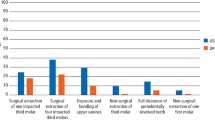Abstract
Objectives
Analgesics are one of the most frequently used medicines. Self-medication and misuse have been described in the literature. The purpose of this study was to document analgesic (mis)use in a population seeking emergency dental treatment.
Material and methods
Patients consulting a dental emergency service were randomly asked to complete a questionnaire on analgesic use, knowledge and information on the analgesics and on their pain history. A photobook was used as an aid to identify products used. Descriptive statistics were combined with chi-square and Mann-Whitney U testing.
Results
Ninety-eight patients were included. Acetaminophen (69.4%) and ibuprofen (65.3%) were the most frequently used products. Nearly half of the subjects (43.9%) combined at least two analgesics. Although 42.9% of subjects were aware of the maximum daily dose, 62.2% of the subjects exceeded this limit, specifically 76.6% of subjects using ibuprofen and 32.4% of subjects using acetaminophen overdosing. Females overdosed significantly more than males. Ingestion on medical advice did not affect the overdose rates significantly. No significant relation was found between the absence of knowledge on the maximum daily dose and actual overdosing. No higher pain reduction was found in patients overdosing analgesics. The average number of days patients experienced pain before consulting the emergency unit was 12. A significant relation was found between the lag time and overdosing.
Conclusions
A large portion of the patients overdosed analgesics. Even prior medical advice did not reduce significantly overdose rates.
Clinical relevance
Dentists treating emergency cases clearly need to be aware of the high risk and high rates of overdosing analgesics in their patients.


Similar content being viewed by others
References
Lipton JA, Ship JA, Larach-Robinson D (1993) Estimated prevalence and distribution of reported orofacial pain in the United States. J Am Dent Assoc 124:115–121
Cazacu I, Mogosan C, Loghin F (2015) Safety issues of current analgesics: an update. Clujul Med 88:128–136
Heard KJ, Ries NL, Dart RC et al (2008) Overuse of non-prescription analgesics by dental clinic patients. BMC Oral Health 8:33
Hersh EV, P a M, Ross GL (2000) Over-the-counter analgesics and antipyretics: a critical assessment. Clin Ther 22:500–548
Heard K, Sloss D, Weber S, Dart RC (2006) Overuse of over-the-counter analgesics by emergency department patients. Ann Emerg Med 48:315–318
Siddique I, Mahmood H, Mohammed-Ali R (2015) Paracetamol overdose secondary to dental pain: a case series. Br Dent J 219:E6
Thomas MBM, Moran N, Smart K, Crean S (2007) Paracetamol overdose as a result of dental pain requiring medical treatment - two case reports. Br Dent J 203:25–28
Dodd MD, C a G (2002) Unintentional overdose of analgesia secondary to acute dental pain. Br Dent J 193:211–212
Nusstein JM, Beck M (2003) Comparison of preoperative pain and medication use in emergency patients presenting with irreversible pulpitis or teeth with necrotic pulps. Oral Surg, Oral Med Oral Pathol Oral Radiol Endod 96:207–214
Heaivilin N, Gerbert B, Page JE, Gibbs JL (2011) Public health surveillance of dental pain via Twitter. J Dent Res 90:1047–1051
Hargreaves K, Abbott PV (2005) Drugs for pain management in dentistry. Aust Dent J 50:S14–S22
Brennan F, Carr DB, Cousins M (2007) Pain management: a fundamental human right. Anesth Analg 105:205–221
Vogel J, Heard KJ, Carlson C et al (2011) Dental pain as a risk factor for accidental acetaminophen overdose: a case-control study. Am J Emerg Med 29:1125–1129
Daly FFS, O’Malley GF, Heard K et al (2004) Prospective evaluation of repeated supratherapeutic acetaminophen (paracetamol) ingestion. Ann Emerg Med 44:393–398
Moore R, Wiffen P, Derry S, et al (2015) Non-prescription (OTC) oral analgesics for acute pain—an overview of Cochrane reviews (Review). Cochrane Database Syst Rev 1–21
Samuelsen P-J, Slørdal L, Mathisen UD, Eggen AE (2015) Analgesic use in a Norwegian general population: change over time and high-risk use—the Tromsø Study. BMC Pharmacol Toxicol 16:16
King J, Doane C, Wilon KM, Wolf MS (2011) Misunderstanding and potential unintended misuse of acetaminophen among adolescents and young adults. J Health Commun 16:256–267
Hurwitz J, Sands S, Davis E et al (2014) Patient knowledge and use of acetaminophen in over-the-counter medications. J Am Pharm Assoc (2003) 54:19–26
Holmström IK, Bastholm-Rahmner P, Bernsten C et al (2014) Swedish teenagers and over-the-counter analgesics—Responsible, casual or careless use. Res Soc Adm Pharm 10:408–418
Ingle JI, Glick DH (2002) Differential diagnosis and treatment of dental pain. In: Ingle JM, Bakland LK (eds) Endodontics, 5th ed. BC Decker Inc. , Hamilton, pp 259–286
Haas DA (2002) An update on analgesics for the management of acute postoperative dental pain. J Can Dent Assoc 68:476–482
Nayyer NV, Byers J, Marney C (2014) Identifying adults at risk of paracetamol toxicity in the acute dental setting: development of a clinical algorithm. Br Dent J 216:229–235
Acknowledgements
A special thanks to Valerie Staelraeve for supporting this research at the emergency department.
Funding
The work was not funded. All work was performed by University staff and no additional costs occurred.
Author information
Authors and Affiliations
Corresponding author
Ethics declarations
Conflict of interest
The authors declare that they have no conflict of interest.
Ethical approval
This article does not contain any studies with animals performed by any of the authors. All procedures performed in studies involving human participants were in accordance with the ethical standards of the institutional and/or national research committee and with the 1964 Helsinki Declaration and its later amendments or comparable ethical standards. The study was approved by the Ethical Committee of the Ghent University Hospital (B670201420818).
Informed consent
Signed informed consent was obtained from all individual participants included in the study.
Rights and permissions
About this article
Cite this article
Hommez, G., Ongena, B., Cauwels, R.G.E.C. et al. Analgesia (mis)usage on a dental emergency service: a patient survey. Clin Oral Invest 22, 1297–1302 (2018). https://doi.org/10.1007/s00784-017-2228-6
Received:
Accepted:
Published:
Issue Date:
DOI: https://doi.org/10.1007/s00784-017-2228-6



